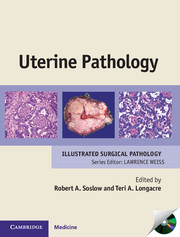Book contents
- Frontmatter
- Contents
- List of contributors
- Preface
- Acknowledgments
- 1 Cytology of the uterine cervix and corpus
- 2 Cervix: squamous cell carcinoma and precursors
- 3 Cervix: adenocarcinoma and precursors, including variants
- 4 Miscellaneous cervical abnormalities
- 5 Non-neoplastic endometrium
- 6 Endometrial carcinoma precursors: hyperplasia and endometrial intraepithelial neoplasia
- 7 Endometrioid adenocarcinoma
- 8 Serous adenocarcinoma
- 9 Clear cell adenocarcinoma and other uterine corpus carcinomas, including unusual variants
- 10 Carcinosarcoma
- 11 Adenofibroma and adenosarcoma
- 12 Uterine smooth muscle tumors
- 13 Endometrial stromal tumors
- 14 Other uterine mesenchymal tumors
- 15 Miscellaneous primary uterine tumors
- 16 Uterine metastases: cervix and corpus
- 17 Gestational trophoblastic disease
- 18 Other pregnancy-related abnormalities
- 19 Lynch syndrome (hereditary non-polyposis colorectal cancer syndrome)
- 20 Cytology of peritoneum and abdominal washings
- Index
- References
10 - Carcinosarcoma
Published online by Cambridge University Press: 05 July 2013
- Frontmatter
- Contents
- List of contributors
- Preface
- Acknowledgments
- 1 Cytology of the uterine cervix and corpus
- 2 Cervix: squamous cell carcinoma and precursors
- 3 Cervix: adenocarcinoma and precursors, including variants
- 4 Miscellaneous cervical abnormalities
- 5 Non-neoplastic endometrium
- 6 Endometrial carcinoma precursors: hyperplasia and endometrial intraepithelial neoplasia
- 7 Endometrioid adenocarcinoma
- 8 Serous adenocarcinoma
- 9 Clear cell adenocarcinoma and other uterine corpus carcinomas, including unusual variants
- 10 Carcinosarcoma
- 11 Adenofibroma and adenosarcoma
- 12 Uterine smooth muscle tumors
- 13 Endometrial stromal tumors
- 14 Other uterine mesenchymal tumors
- 15 Miscellaneous primary uterine tumors
- 16 Uterine metastases: cervix and corpus
- 17 Gestational trophoblastic disease
- 18 Other pregnancy-related abnormalities
- 19 Lynch syndrome (hereditary non-polyposis colorectal cancer syndrome)
- 20 Cytology of peritoneum and abdominal washings
- Index
- References
Summary
INTRODUCTION
Carcinosarcoma, also referred to as “malignant mixed mullerian tumor” or “MMMT,” is a neoplasm composed of malignant-appearing epithelial and mesenchymal elements. Although they can arise in any genital organ, carcinosarcomas are found most frequently in the uterus, where they represent less than 5% of malignant neoplasms. These tumors are increasingly thought of as carcinomas that demonstrate sarcomatoid differentiation. Revisions to the FIGO staging system and the seventh edition of the AJCC Cancer Staging Manual now formally encourage the same staging scheme as for carcinomas: tacit recognition that, in general, carcinosarcomas are closely related to carcinomas. Advances in our understanding of the interplay of tumor biology and epidemiology, along with the increasing use of comprehensive surgical staging and treatment with effective chemotherapeutic agents, have led to the conclusion that carcinosarcoma constitutes a specific clinicopathologic entity, distinct from many other biphasic uterine tumors. The typical carcinosarcoma is a biphasic, mixed epithelial and mesenchymal tumor, the clinical evolution of which is more aggressive than high-grade endometrial carcinoma.
CLINICAL CHARACTERISTICS
The mean age of patients with endometrial carcinosarcoma is in the seventh decade. Carcinosarcoma is uncommon earlier in life. Vaginal bleeding is typical, but the prototypic presentation is a polypoid mass that protrudes through the cervical os.
The five-year survival rate for carcinosarcoma is approximately 30%, and the five-year survival rate in surgical stage I disease (confined to uterus) is approximately 50%. This very aggressive profile contrasts with that of other high-grade endometrial cancers where five-year survival rates in stage I disease are approximately 80%.
- Type
- Chapter
- Information
- Uterine Pathology , pp. 196 - 204Publisher: Cambridge University PressPrint publication year: 2012



